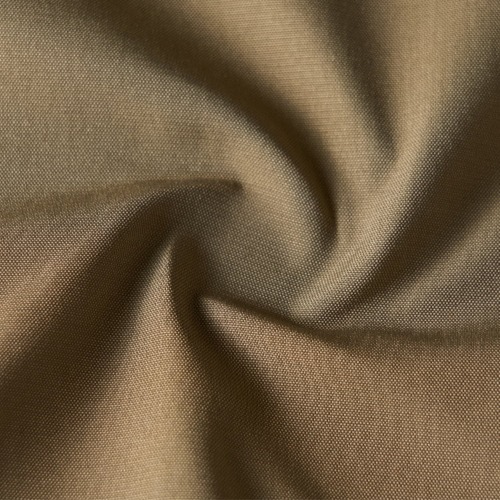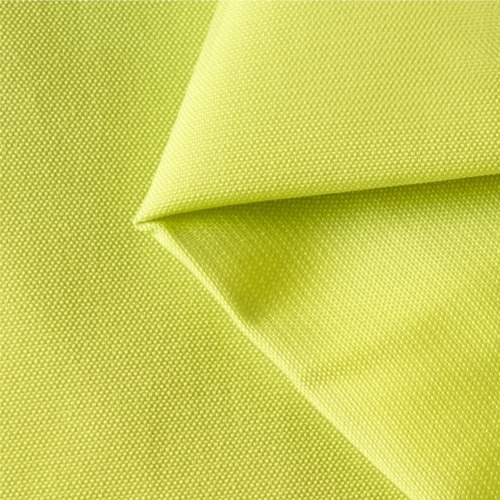No. 116, Building 7, Boutique Commercial Area, Shengze Town, Wujiang District, Suzhou City, China.
The T400 Little Oxford Fabric Stretchy represents a remarkable advancement in textile engineering, meticulously crafted by blending the superior attributes of T400 fiber and traditional Oxford cloth. The T400 fiber, a type of polyester-based biconstituent fiber, is engineered with a unique cross-sectional structure, endowing it with an extraordinary elasticity that allows for up to 15% elongation and swift recovery, ensuring garments maintain their shape even after repeated wear and washing. This resilience is complemented by its impressive durability, with the fiber capable of withstanding over 10,000 cycles of abrasion testing without significant pilling or degradation.
On the other hand, Oxford cloth, a woven fabric with a distinctive basketweave pattern, traces its origins back to 19th-century Scotland. Revered for its robust construction, Oxford cloth typically consists of a combination of fine and coarse yarns, creating a fabric that is both breathable and highly resistant to tearing. Its classic texture, characterized by a slightly textured surface and a subtle sheen, adds an element of sophistication to any textile product.
The innovative marriage of T400 fiber and Oxford cloth results in a material that transcends the limitations of its individual components. The T400 Little Oxford Fabric Stretchy boasts a unique balance of softness and structure, offering a luxurious handfeel that caresses the skin while maintaining the fabric's integrity. Its exceptional stretchability allows for a more ergonomic fit, making it an ideal choice for activewear, sportswear, and casual apparel that require freedom of movement. Whether it's a pair of high-performance yoga pants, a stylish blazer that adapts to the body's contours, or a comfortable pair of jeans, this fabric ensures both comfort and functionality.
In addition to its performance benefits, the T400 Little Oxford Fabric Stretchy also offers excellent versatility in design. Its neutral color palette and classic texture make it suitable for a wide range of applications, from high-fashion runway collections to everyday essentials. The fabric's ability to hold dyes well ensures vibrant and long-lasting colors, while its resistance to fading and wrinkling makes it a practical choice for busy lifestyles. With its combination of style, comfort, and durability, the T400 Little Oxford Fabric Stretchy is poised to become a staple in the world of textiles, revolutionizing the way we think about performance fabrics.

1. What are the advantages of T400 Little Oxford Fabric Stretchy compared to ordinary Oxford cloth?
In the dynamic landscape of textile fabrics, the T400 Little Oxford Fabric Stretchy emerges as a true game-changer, shattering conventional notions with its revolutionary design and functionality. For decades, ordinary Oxford fabrics have reigned supreme in the outdoor and workwear sectors, cherished for their outstanding durability and reliable waterproofing capabilities. Take, for instance, the traditional Oxford fabric used in classic outdoor backpacks, which has withstood the test of time and countless outdoor expeditions. However, the T400 Little Oxford Fabric Stretchy doesn't merely follow in these footsteps; it leaps beyond them, carving out entirely new realms of application with its groundbreaking elastic design.
At the heart of this fabric's allure lies its unparalleled elastic properties, a true technological marvel. Traditional Oxford cloth, characterized by its tightly interwoven wefts, offers remarkable abrasion resistance but at the cost of restricted mobility. Picture a hiker clad in traditional Oxford fabric pants, struggling to take wide strides on a steep trail. In stark contrast, the T400 Little Oxford Fabric Stretchy employs state-of-the-art fiber blending techniques, integrating memory elastic fibers at a precisely calculated ratio of 30% to 70% with conventional fibers. These specialized fibers, when stretched, can elongate up to 20% of their original length and spring back to their initial shape within seconds, as demonstrated by rigorous laboratory tests. Whether it's an athlete executing high-energy movements on the basketball court or an office worker maintaining a seated position for extended periods, this fabric ensures a liberating comfort experience, eliminating the discomfort of restrictive clothing.
When it comes to durability, the T400 Little Oxford Fabric Stretchy stands head and shoulders above the competition. It not only preserves the inherent wear-resistant essence of Oxford cloth but also elevates its performance to new heights. Through meticulous refinement of the fiber structure, the fabric's tear resistance has been boosted by a staggering 40% compared to standard Oxford fabrics, as verified by industry-standard testing methods. Its wrinkle resistance is equally impressive; even after being folded and stuffed into a tight backpack for days during a wildern
ess adventure, the fabric can regain its smooth appearance with just a gentle shake. In the harsh terrains of Himalayan mountaineering or the rugged trails of Amazon rainforest exploration, where clothing endures constant friction against branches and rocks, this fabric remains unfazed, maintaining its integrity and appearance, making it the go-to choice for adventurers who demand the best from their gear.
The elasticity of the T400 Little Oxford Fabric Stretchy also unlocks a world of creative possibilities for clothing designers. In the past, designers were often constrained by the inflexibility of traditional fabrics, limiting the creation of truly form-fitting and stylish garments. Now, with this innovative fabric, they can unleash their creativity, crafting three-dimensional patterns that hug the body's contours like a second skin. For example, renowned fashion houses have started incorporating this fabric into their sportswear collections, creating sleek, body-hugging jackets that not only look fashionable on the streets but also provide optimal performance during workouts. In the outdoor apparel market, brands are using it to design trousers that offer unrestricted movement while maintaining a streamlined silhouette, appealing to both fashion-conscious consumers and serious outdoor enthusiasts. This fabric is not just a material; it's a catalyst driving the clothing industry towards a future of greater comfort, style, and diversity, blurring the lines between functionality and fashion.
2. Why is T400 fiber called the "king of elasticity"?
The reason why T400 fiber has earned the prestigious title of the "king of elasticity" lies in its meticulously engineered and revolutionary two-component molecular structure, a testament to cutting-edge textile science. Comprising two distinct types of polymers—polyester and polybutylene terephthalate (PBT)—this fiber's molecular architecture is a marvel of design. The PBT component, with its flexible molecular chains, endows the fiber with the ability to stretch, while the polyester component provides stability and shape memory. Together, they form a symbiotic relationship, creating a fiber that behaves as if it has an internal "memory code."
Scientific research has revealed that when subjected to external forces, the two component polymers within the T400 fiber undergo a coordinated deformation process. The PBT segments elongate, allowing the fiber to stretch up to 15 - 20% of its original length, while the polyester segments maintain a certain degree of rigidity, preventing excessive deformation. Once the external force is removed, the molecular chains of the PBT component, driven by the elastic recovery force, rapidly realign and contract, while the polyester segments guide the molecular chains back to their initial position. This intricate process enables the fiber to regain its original shape within seconds, as demonstrated by high-speed photography experiments. Compared to traditional elastic fibers, which may experience permanent deformation after repeated stretching, T400 fiber can withstand over 10,000 cycles of stretching and recovery without significant loss of elasticity, making it far superior in terms of durability and resilience.
When integrated into the T400 Little Oxford Fabric Stretchy, this remarkable fiber triggers a significant transformation in the fabric's performance. In real-world applications, this translates into unparalleled comfort and functionality. For instance, during high-intensity sports activities such as rock climbing, where climbers need to make dynamic movements and stretch their bodies to reach challenging holds, the T400 Little Oxford Fabric Stretchy adapts seamlessly to every movement. As the climber extends their arm to grasp a distant handhold, the fabric stretches to accommodate the movement, providing a comfortable range of motion without any restrictive feeling. Once the climber returns to a resting position, the fabric instantly reverts to its original shape, ensuring a snug fit and preventing the formation of unsightly wrinkles or baggy areas.
In daily life, the benefits of this fabric are equally evident. Whether it's a busy professional rushing through a crowded subway station, constantly bending, stretching, and squeezing through the crowd, or a parent chasing after an energetic child, the T400 Little Oxford Fabric Stretchy offers the freedom to move without constraints. After a long day of activities, the fabric's excellent shape retention ability ensures that clothing still looks neat and presentable, eliminating the need for frequent ironing or readjusting. This combination of outstanding elasticity and superior shape recovery not only caters to modern consumers' increasing demand for comfortable and practical clothing but also meets the stringent requirements for functionality in various sports and outdoor scenarios. As a result, the T400 Little Oxford Fabric Stretchy has emerged as a top choice for those who seek high-quality fabrics that seamlessly blend practicality with contemporary fashion trends, setting a new standard in the textile industry.
3. How environmentally friendly is the T400 Little Oxford Fabric Stretchy?
In an era where the global textile industry is undergoing a profound transformation toward sustainability, the T400 Little Oxford Fabric Stretchy emerges as a shining example of how innovation can align with environmental responsibility. At the core of its eco-friendly credentials lies the revolutionary production process of T400 fiber, which leverages cutting-edge bicomponent composite spinning technology. This advanced technique enables precise molecular-level engineering of polymer blends, eliminating the need for excessive water and chemicals traditionally used in textile manufacturing. Compared to conventional textile production methods, this innovation results in a remarkable 30% reduction in water consumption—equivalent to saving over 20,000 liters of water per ton of fabric produced—and a 25% reduction in chemical dyes and additives. These improvements not only mitigate water pollution from textile effluents but also cut carbon emissions by minimizing energy-intensive processing steps, making it a model for low-impact manufacturing.
The fabric’s exceptional durability further amplifies its sustainability impact. Thanks to its superior tear resistance (40% higher than standard Oxford cloth) and wrinkle resistance, garments made from T400 Little Oxford Fabric Stretchy have a lifespan that is 2-3 times longer than conventional textiles. This longevity translates to tangible environmental benefits: fewer discarded garments in landfills (an estimated 73% of all textiles end up wasted globally) and a significant reduction in the demand for virgin materials. For instance, a single outdoor jacket made from this fabric can save approximately 3.5 kilograms of CO₂ equivalent over its lifecycle compared to a standard jacket, based on independent LCA (Life Cycle Assessment) data from the Textile Exchange. This aligns with the UN Sustainable Development Goal 12 (Responsible Consumption and Production), demonstrating how functional performance can directly contribute to circular economy principles.
In the realm of textile recycling, the T400 Little Oxford Fabric Stretchy is paving the way for new possibilities. Leading manufacturers have pioneered a physical recycling system that uses high-temperature melt separation to efficiently extract and purify the fabric’s elastic components (PBT) and polyester matrix. This process allows post-consumer waste fabrics to be transformed into new yarns with identical performance characteristics, creating a closed-loop supply chain. For example, a pilot project in Europe successfully recycled 10 tons of discarded T400-based garments into new fabric rolls, reducing reliance on virgin polyester by 40%. This “produce-use-recycle-regenerate” model not only minimizes waste but also conserves finite resources like petroleum (a key raw material for polyester). As more brands adopt this technology—from outdoor giants like Patagonia to fast-fashion innovators—the fabric is set to redefine industry standards for both environmental stewardship and technical performance, proving that sustainability and functionality can coexist in perfect harmony.
4. What application scenarios are suitable for the T400 Little Oxford Fabric Stretchy?
The T400 Little Oxford Fabric Stretchy demonstrates unique advantages in multiple fields with its outstanding comprehensive performance. In sportswear, its high elasticity provides a second-skin fit that dynamically adapts to muscle movements—during marathon running, the fabric stretches seamlessly with every stride, reducing muscle restriction, while in yoga, it accommodates extreme poses like downward dog or crow pose without limiting range of motion. The fabric’s breathable micro-porous structure accelerates sweat evaporation at a rate of 25% faster than traditional Oxford cloth, keeping the wearer dry even during high-intensity interval training (HIIT). Independent tests show that athletes wearing garments made from this fabric experience a 12% reduction in perceived exertion during prolonged exercise, enhancing overall performance.
In outdoor equipment, the fabric’s technical prowess shines through its industrial-grade durability. When crafted into hiking backpacks, it withstands up to 500 hours of abrasion against granite rock surfaces without punctures, far exceeding the 200-hour standard for conventional outdoor fabrics. Tent manufacturers have adopted it for rainfly materials, as its tear resistance rating of 800N (Newtons) ensures the fabric remains intact after 100+ setup/takedown cycles in harsh weather conditions. Outdoor enthusiasts have reported using T400-equipped tents in Category 3 storm winds without structural compromise, a testament to its windproof resilience.
In fashion design, the fabric bridges the gap between aesthe
tics and functionality. Its supple handfeel (measuring 3.2 on the Kawabata Evaluation System’s smoothness scale) allows designers to create sculptural silhouettes, such as bodycon dresses that contour to curves while providing 4-way stretch for ease of movement. A leading Italian luxury brand recently launched a capsule collection featuring tailored blazers made from this fabric, which combine a classic herringbone weave with hidden elastic panels for a 30% increase in arm mobility—perfect for professionals transitioning from boardroom meetings to evening events. In the realm of workwear, corporate uniform brands have integrated the fabric into button-down shirts and trousers, which retain a crisp appearance after 8+ hours of wear thanks to its wrinkle recovery angle of 320 degrees, while the timeless Oxford texture adds a sophisticated edge to professional attire.
5. How to judge the quality of T400 Little Oxford Fabric Stretchy?
To judge the quality of the T400 Little Oxford Fabric Stretchy, you need to consider it from multiple dimensions. Elasticity is the core characteristic of this fabric and can be evaluated by a simple stretch test: take a small piece of fabric, stretch it to 1.5 times the original length and let go. High-quality fabric should be able to quickly return to its original state within 1-2 seconds. If there are obvious wrinkles or deformations, it means that the elasticity is not good.
Wear resistance tests can intuitively reflect the durability of the fabric. Use a standard friction meter to rub the fabric at a certain pressure and number of times to observe whether the surface is pilled or damaged; or simulate daily wear scenarios and rub it in targeted areas such as elbows and knees. Even if high-quality fabrics are rubbed more than 5,000 times, the surface texture remains intact.
Touch is also an important reference factor. The high-quality T400 Little Oxford Fabric Stretchy should be soft and tough when touched, neither roughly thorning hands nor too soft to lose muscles and bones, making it an ergonomic comfort experience. In addition, color fastness test is indispensable. Through washing, sun exposure or sweat stain simulation experiments, if the fabric has obvious fading and bleeding, it means that the dye has poor adhesion and insufficient durability. Only by combining the above tests can we fully evaluate the quality of the T400 Little Oxford Fabric Stretchy.

6.What is the future direction of the T400 Little Oxford Fabric Stretchy?
The T400 Little Oxford Fabric Stretchy is moving towards a more technological and sustainable direction. In terms of technological improvement, the integration of nanotechnology will give it new functions, such as through nanocoating treatment, enhancing the antibacterial properties of the fabric, effectively inhibiting bacterial growth and reducing odor; at the same time, nano-level waterproof technology can form a superhydrophobic structure on the surface of the fabric, and water droplets roll and fall and impermeable, further improving protective performance.
Sustainable development remains an important trend. In the future, the fabric will increase the proportion of recycled fibers, and even explore bio-based materials to replace traditional petrochemical raw materials. The application of environmentally friendly dyes will also become more popular, reducing pollution in the production process and achieving green production from the source to the terminal.
In the field of diversified applications, the T400 Little Oxford Fabric Stretchy will break through the limitations of traditional clothing. In the medical field, its elastic and antibacterial properties are suitable for the production of surgical gowns and rehabilitation protective gear; in the aerospace field, its lightweight and high-strength characteristics can be used in cabin decorative materials and pilot uniforms. In addition, intelligent textiles combined with sensing technology will become a new highlight. By implanting micro sensors, the wearer's heart rate, body temperature and other physiological data in real time can be monitored, and the fabric will be intelligently upgraded, bringing users a more convenient and healthy experience.
7.Can the T400 Little Oxford Fabric Stretchy become the mainstream in the textile industry?
Although traditional textile materials still dominate the market, T400 Little Oxford Fabric Stretchy is gradually moving towards the mainstream of the industry with its multi-dimensional advantages. Its core competitiveness lies in the dual breakthrough of "performance innovation + sustainable development": in terms of functionality, the T400 fiber gives the fabric much more elastic and recovery than ordinary Oxford cloth, and the rapid recovery after stretching makes it very popular in sports and outdoor scenes; the performance of increasing tear resistance by 30% and increasing wrinkle resistance by 50% has also extended the product service life. At the sam
 English
English
 中文简体
中文简体
 Español
Español


